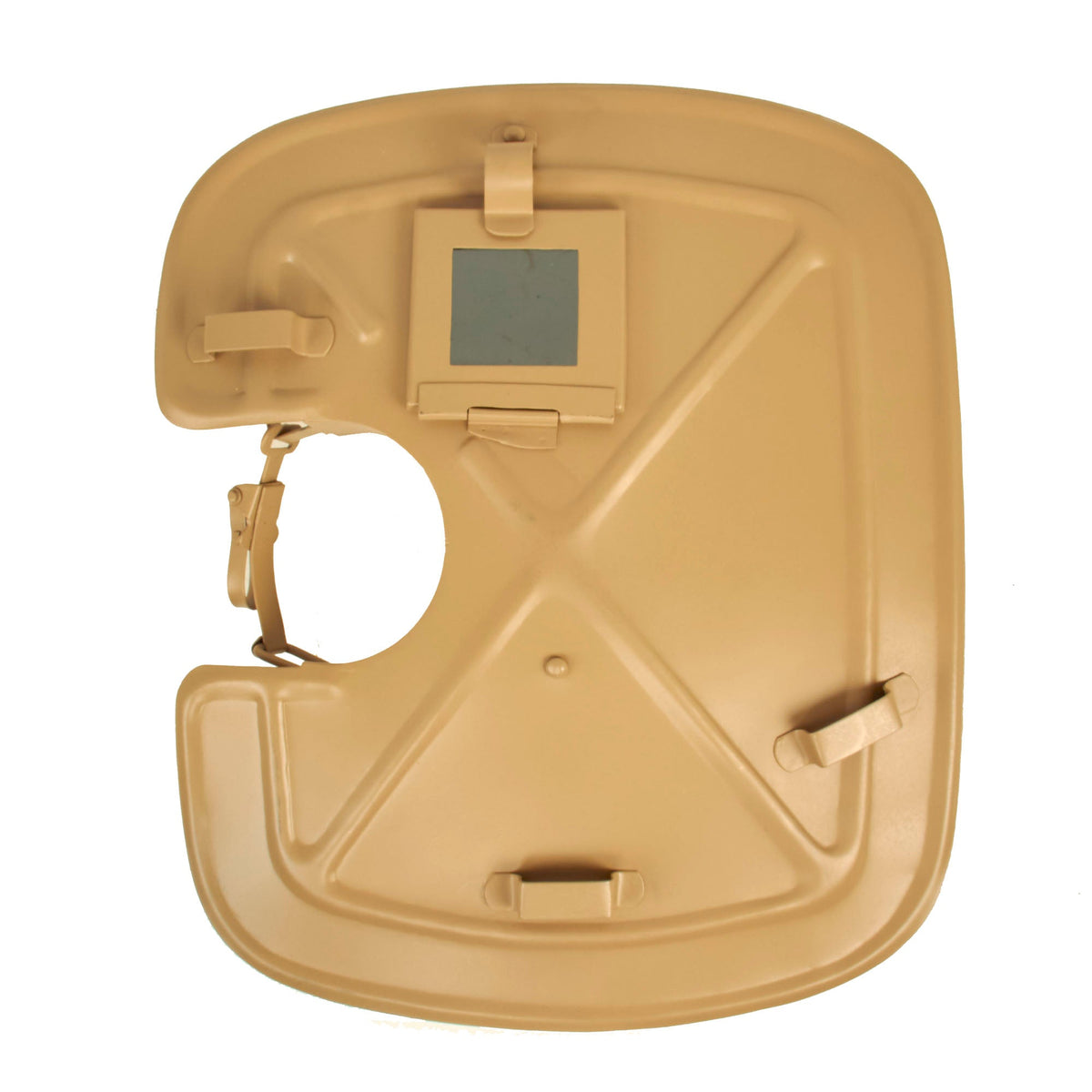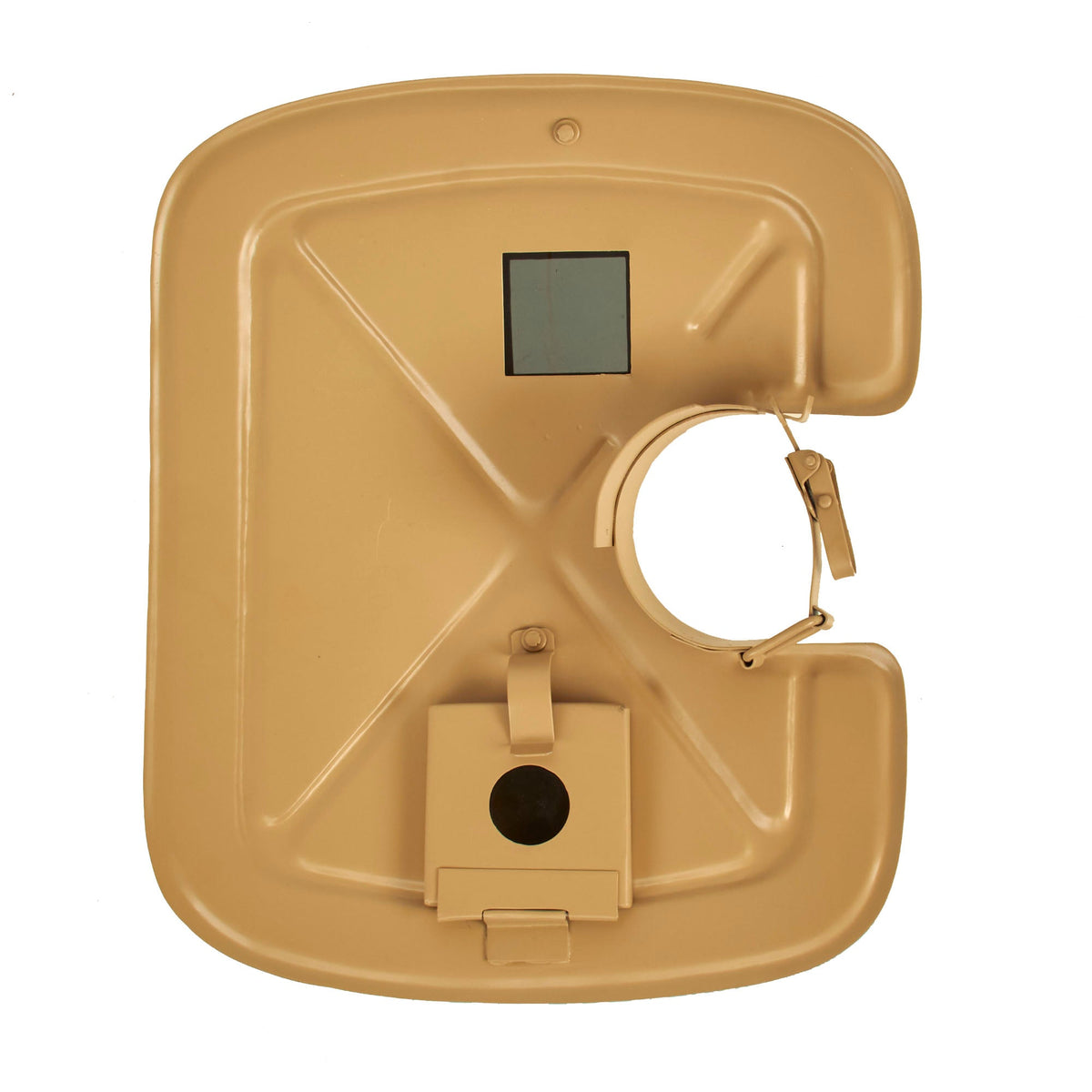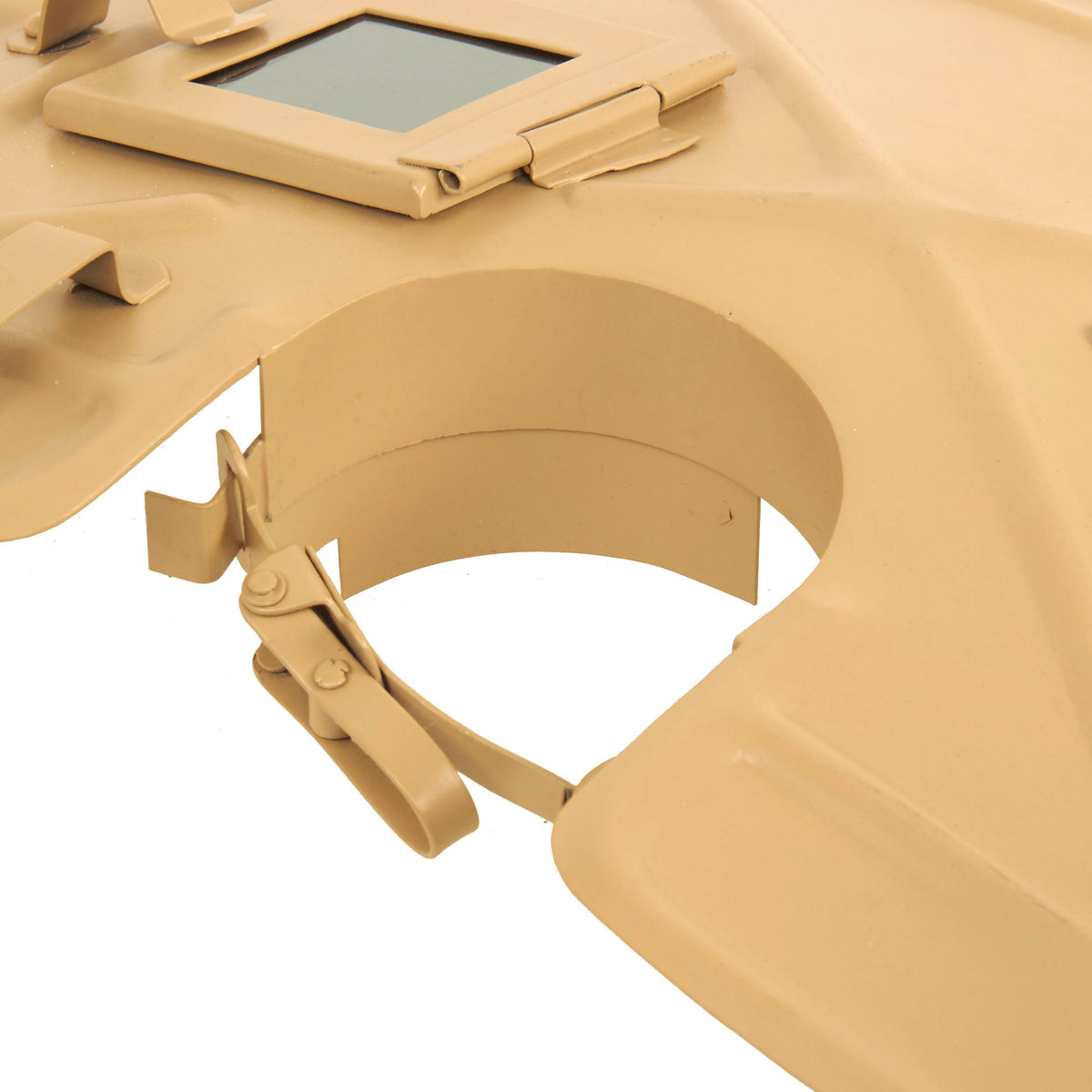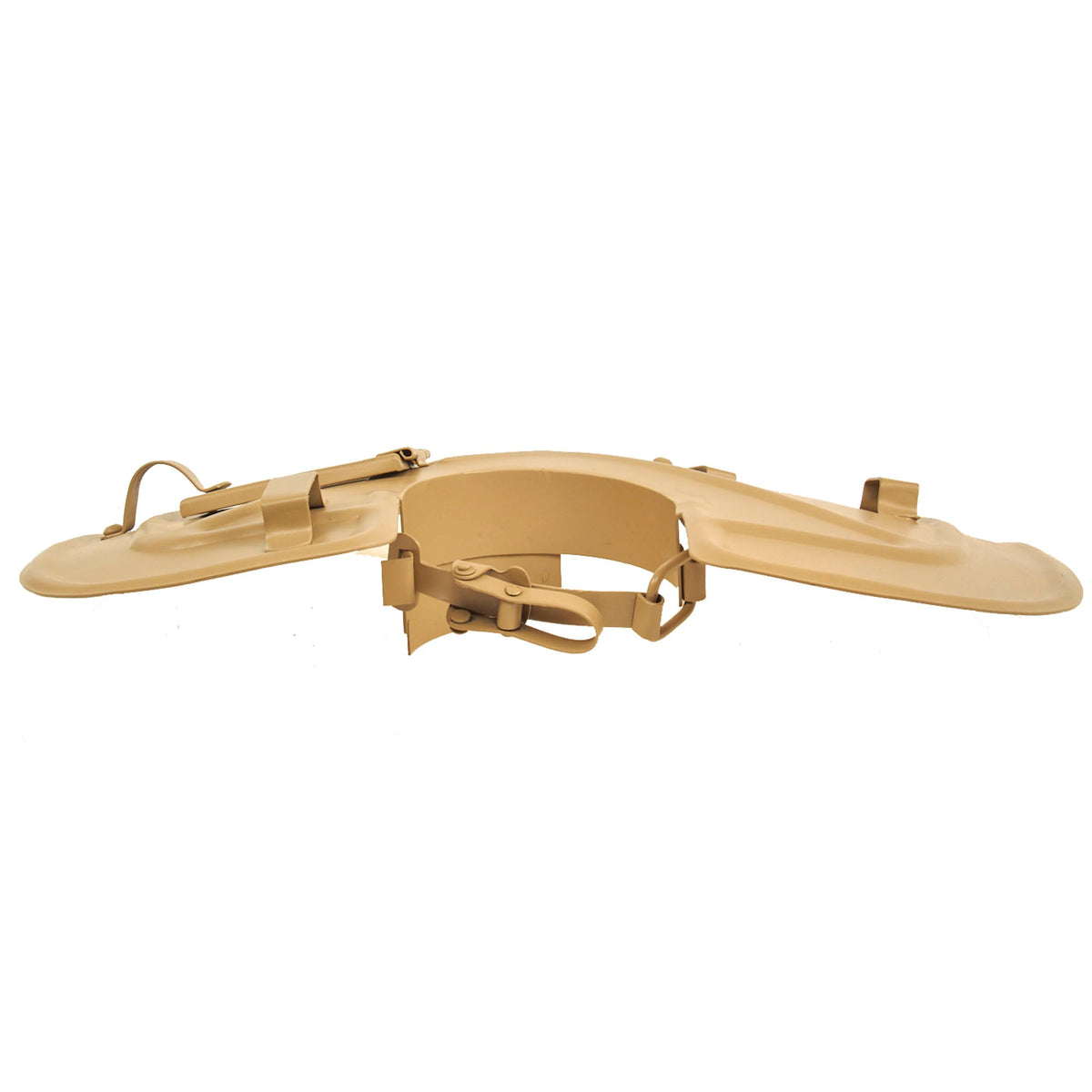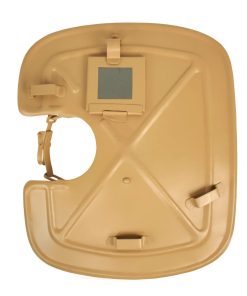German WWII Panzerschreck RPzB 54 Anti-Tank Rocket Launcher Blast Shield – Dunkelgelb New Made Items
$ 125,00 $ 50,00
New Made Item: An IMA exclusive! For a few years awful reproductions were available, so we decided to exclusivity manufacture our own non-functioning reproduction of the legendary Panzerschreck, copied directly from an original in the IMA collection. However, we have also had many requests for having just the blast shields available, as there are many deactivated Panzerschreck launchers out there missing theirs.
You asked, and we listened! We have had a small number of these shields manufactured, complete with tinted glass, measuring approximately 16″ x 13″. They are the exact same ones that come with our complete launchers. These should fit any Panzerschreck that has an original dimension tube, though some fitting / adjustment may be required. Each is painted the correct dunkelgelb (dark yellow) tan color used on the originals.
Ready to fit to your Panzerschreck tubes!
History of the Panzerschreck RPzB.54- The RPzB 43 Panzerschreck (Tank Terror) was an enlarged version of the U.S. M1 Bazooka being scarcely more then a length of steel tube with a shoulder rest and firing arrangements attached, hence the alternative German nickname of Ofenrohr (Stovepipe). The caliber was selected simply because 88mm hollow charge warheads were already in production for launching from the R-Werfer 43 but with rockets for the RPzB 43 there was a difference. Having noted that the American M6 HEAT rocket was ignition method was altered accordingly, resulting in the RPzBGr 4322 weighing 3.25kg (7.2lb). However the Germans decided not to adopt the battery-powered ignition circuitry rapidly developing and adopting a magneto-driven ignition method. It is interesting to note that the Americans later adopted a magneto ignition system for their M9/M9A1 launchers.
The unexpected advent of the M1 Bazooka in Tunisa made a considerable impact on the German military establishment. Not only did the Bazooka concept present a considerable danger to German armor but the simplicity, low cost and potential of the launchers design made a great impression. The immediate result was the abandonment of the R-Werfer 43 in favor of the novel Bazooka rocket delivery system. Within weeks the first examples of the 88mm (3.4in) Raketenpanzerbüchse43 (88mm RPzB 43) were coming off the HASAG production line at Meuselwitz. Most R-Werfer 43’s already produced were sent to Tunisia or Italy and were soon forgotten or lost in action. Many were diverted and placed among the defensive works covering the Normandy beaches as part of the Atlantic Wall defenses.
The weight of a loaded 88mm RPzB 43 was 9.5kg (20.9lb). Amour penetration performance remained as before ie 160mm (6.24in) of amour plate set at an angle of 60°. The length of the RPzB 43 (1.64m) meant that to handle it effectively called for a team of two, one acting as the loader and carrying five ready-use rockets on a special backpack frame. Only when a target approached was a rocket loaded into the rear of the launching tube where it was held by a retaining catch and connected by the loader to the firing circuit via two thin wires. The firer used simple fixed sights for aiming and cocked the firing arrangements by pulling back a spring-loaded lever. Operating the trigger produced a current for a primer to ignite the rocket motor and launch the rocket.
RPzB 43 teams had to be masters of concealment and stealth for the practical range of the RPzBGr 4322 rocket was a maximum of 150m (492ft). Combat ranges were frequently considerable less. A trained team could launch four or five rockets in one minute. Panzerschreck warheads were also highly effective against field fortifications or buildings during fighting in built up areas.
The RPzB 43 was very rapidly accepted into service and soon became the preferred portable anti-tank weapon for infantry formations. By 1944 the weapon was so well integrated that each infantry regiment had an establishment of 36 held by the regimental anti-tank company, along with three 75mm (2.9in) Pak 40 towed anti-tank guns. The so-called Volksgrenadier infantry regiments of the latter war years were meant to have a planned 72 Panzerschrecken.
By mid-1944 the RPzB 43 was well into the process of being withdrawn from front line units in favor of the improved 88mm (3.4in) RPzB 54. The RPzB.54 Panzerschreck antitank rocket launcher differs from the Ofenrohr primary by addition of the protective steel shield with aiming glass window, which protects shooter”s face and hands from rocket back blast. Another improvement is more elaborate sight, which allows for better windage, temperature and range adjustments, as well as the addition of 4 steel “flutes” which run the length of the barrel and increased strength.
By 1944 the Panzerschreck series had already become so important that production was in progress in seven centers and many others were concerned with sub assemblies. The simplicity of the RPzB 54 and its lack of demand for critical raw materials or manufacturing resources were such that it became an integral weapon in the German effort.
Prompt Shipping and Professional Packaging
We provide a variety of shipping options due to our long-running partnerships with UPS, FedEx and DHL. Our warehouse personnel are well trained and will pack the goods according to our exact and precise specifications. Before shipping your items will be thoroughly inspected and secured. Every day, we deliver to thousands of customers in different countries. This is a sign of our determination to become the largest online retailer worldwide. Both Europe as well as the USA have warehouses and distribution centers.
Note that orders containing more than one item will be subject to a processing period that is based to the particular item.
Prior to shipping the items, our staff will carry out an exhaustive inspection of the products you ordered. Today, most orders will be delivered within 48 hours. The estimated delivery time is between 3-7 days.
Returns
The stock is constantly changing. It's not entirely managed by us since we are involved with multiple entities, including the factory and our storage. Therefore, the actual inventory could alter at any time. It is possible that you will not receive your order after the order has been made.
The period of time is 30 days. Unfortunately, if 30 days have passed since you purchased your product, we are unable to provide a refund or exchange.
The item must not be in use and must be in the original packaging. The item must be in the original packaging.
Related products
Uncategorized
Uncategorized
Uncategorized
Australian WWII Owen MK1 Machine Carbine SMG Custom Fabricated Replica with Sling Original Items
Uncategorized
Uncategorized
Uncategorized
Armoured Fighting Vehicles of the World: AFVs of World War One (Hardcover Book) New Made Items
Uncategorized
Uncategorized
Uncategorized
Uncategorized
Uncategorized
Uncategorized
Uncategorized
Uncategorized
Uncategorized
Uncategorized
Uncategorized
Armored Burgonet Helmet & Polearm from Scottish Castle Leith Hall Circa 1700 Original Items
Uncategorized
